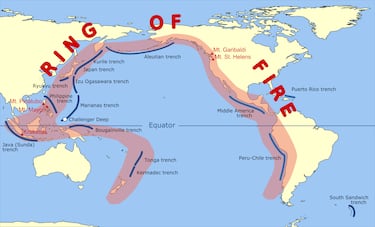Earthquake shakes southwest Japan: Why are there so many tsunamis in the Pacific Ocean?
The huge wave of water known as a tsunami, can be incredibly destructive as it surges onshore carrying all but the most solid objects inland.

A magnitude-6.9 earthquake struck Japan’s Kyushu region late Monday night, prompting brief tsunami advisories for coastal areas in Miyazaki and Kochi prefectures. The waves, initially projected to reach heights of 3.3 feet, ultimately measured just 7.8 inches when they reached Miyazaki city. All advisories were lifted hours later, and no damage or injuries were reported.
The quake, which originated near the Nankai Trough, did not increase the risk of a feared megaquake, according to the Japan Meteorological Agency. However, it was a stark reminder of the Pacific’s seismic volatility, where events like this frequently give rise to tsunamis, some with catastrophic consequences.

What is a tsunami?
Massive wave surges occur when a large amount of water is displaced, either by something falling into the ocean or by displacing the land underneath. Tsunamis occur globally but are most frequent in the Pacific and Indonesia. Around 80 percent of tsunamis occur in the Pacific Ocean because of the extensive tectonic plate activity, which has led scientists to dub the area the ‘Ring of Fire.’

The powerful natural phenomenon can affect any area along a large body of water, and extremely destructive tsunamis have occurred in the Atlantic and Indian Oceans, as well as the Mediterranean Sea.
Tsunamis are not like other ocean waves
Tsunamis should not be confused with “tidal waves” which are caused by the tides which rise and fall due to the gravitational force of the Moon. Nor are they like regular ocean waves that are produced by the wind and storms. Powerful storms such as hurricanes can produce surges that penetrate far inland but tsunamis are a different beast.
Tsunamis are not like regular waves that break in a curling action. They are more similar to fast-moving tides, traveling across the open ocean at speeds of up to 500 miles per hour. In deep water, the ocean may only rise by a foot or so, but as the tsunami approaches shallow water, the wave slows down and grows in height. When a tsunami reaches the shore, it can inundate coastal areas for hours, pushing far inland.
What causes tsunamis? What is the highest ever wave?
The primary trigger for tsunamis is large underwater earthquakes that shift the seabed vertically. Landslides, whether underwater or on land, and ice falling into the ocean, volcanic eruptions, and meteor impacts, can also produce a tsunami. Because of the high number of subduction zones under the Pacific Ocean and Indonesia, these areas are more prone to experiencing these awe-inspiring forces of nature. The highly geologically active region is known as “the Ring of Fire” due to the high concentration of volcanoes around the Pacific Ocean and across the Indonesian archipelago.
Tsunamis can range in size from the imperceivable to monstrous waves that can raze nearly everything in their path. The highest reliably recorded tsunami occurred in 1958 in Alaska when a massive landslide fell into Lituya Bay. The resulting wave that crashed into the other side of the bay was 1,700 feet high.
Most destructive tsunamis throughout history
Related stories
Numerous tsunamis have occurred throughout history, but one of the most destructive and deadliest in recorded history was the 2004 Boxer Day Tsunami in the Indian Ocean. An earthquake with a magnitude of 9.1 to 9.3 off the coast of Sumatra in Indonesia produced waves over 100 feet high. It resulted in almost 230,000 people either dead or missing around the Indian Ocean.
The Lisbon earthquake of 1755 produced an almost 50-foot-high tsunami that destroyed the city and ravaged the coasts of the Iberian Peninsula and Northern Coast of Africa. The flooding and subsequent fire killed perhaps 50,000 people and are credited with starting modern seismology.
Complete your personal details to comment